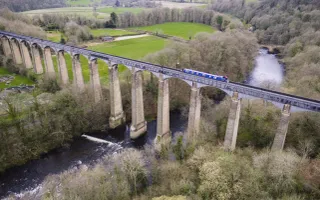During the past ten weeks, our experts have replaced the worn-out lock gates at the top and bottom ends of the 200-year-old Lock 12.
Vital works
At the same time, our colleagues and volunteers have also carried out other vitally important works as part of a national targeted six-month programme of maintenance and repair that will help improve the resilience of the centuries-old canal network to climate change.
Each of the oak lock gates had to be hand crafted to precise measurements at the charity’s specialist workshop at Stanley Ferry, near Wakefield. The largest of those replaced at Lock 12 weighs 3.5 tonnes and measures over 4.5 metres high.
A 150-tonne crane with a 66-metre-long telescopic arm, called a ‘boom’, which was situated above the canal embankment on a road, carefully lifted the gates over the towpath and manoeuvred them into the drained lock chamber, where our specialists carefully fitted them into position.
Looking after our network
Antony License, our site supervisor, said: “Our charity works tirelessly to look after 2,000 miles of canal and river navigations in England and Wales. It involves colossal effort and skill. We have to replace each lock gate around every 25 years, so that they remain strong and operable for the passage of boats.
“During the work at Lock 12, which required the water to be temporarily drained from the lock, we also made other vital repairs. The work took place over the winter months when fewer boats use the canal network, so it’s less disruptive to boaters.
“We used a cofferdam - a watertight enclosure pumped dry to allow us to work in the lock - to hold back the river on one side, and we drained the canal pound on the other side. We’ve done repair work in the lock chamber, upgraded ladders, fitted new steel grooves for stop planks, while additional repairs to the canal have been undertaken further upstream. It’s a costly undertaking, so we collaborated across our teams and volunteers to carry out as many repairs as possible at the same time to keep costs down.”
The damage of climate change
Dating back 250 years, our free-to-visit canal network, is an incredible manmade structure spanning 2,000 miles across England and Wales – including 320 miles in Yorkshire. Remarkably, canals are busier with more boats than the height of the industrial revolution, bringing nature, green space and traffic-free walking and cycling routes to millions of people in many of the country’s most urban areas.
And whilst the canal network has been repurposed for modern society, unfortunately, due to its age and the unrelenting passage of time, more frequent and severe storms are bringing flooding and landslips and causing unprecedented damage. Yorkshire’s historic canals, which incorporate centuries-old hand-crafted bridges, locks, tunnels, embankments and aqueducts, need action to ensure that they aren’t irreparably damaged by climate change.
Keeping canals open and safe
Richard Parry, our chief executive, said: “Britain’s ageing canals are a national treasure. Keeping the canals open and safe requires millions of pounds and a year-round effort. They have been repurposed for modern society for leisure, recreation and for their wildlife, supporting thousands of jobs and the economy and saving the NHS over £1 billion annually because of the health and wellbeing they bring to millions of people.
“Our specialist teams of skilled workers and volunteers continue to give long hours, carrying out heritage conservation works, and fighting to respond to the storms that are becoming ever more common. We’re talking to government about the need for an active partnership, and we’re calling on people to donate, volunteer and help us safeguard our canals and rivers for the future.”
We recently launched our first fundraising campaign to raise much needed support in the face of the rising cost of repairing storm and flood damage. It is also calling on people to support their local canal by becoming a volunteer.





